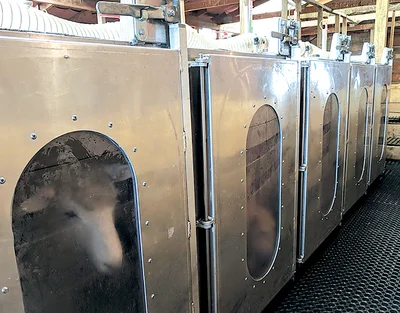Low methane-emitting sheep show the way

Low methane-emitting sheep have made the headlines recently and one farm that has got on the bandwagon is Orari Gorge Station, just on the south side of the Rangitata River, near Peel Forest.
Owner Robert Peacock said he had been breeding for low methane-emitting sheep for three seasons now.
Orari Gorge had two studs, a romney and a romney-texel, and he was measuring both for low methane emissions.
AgResearch had a trailer that visited breeders with 12 Portable Accumulation Chambers (PAC) that could take one sheep at a time, he said.
Sheep went into the chamber for an hour and had their methane and CO2 emissions measured. They had to be well-fed beforehand with no change of diet for a few weeks.
Each animal was weighed on the day of the measurements and needed to be off-feed for at least an hour but no more than three hours before they went into the chamber.
This happened twice, at a 14-day interval. The resulting information was then used alongside other genetic information to calculate the methane value.
There was quite a bit of work involved, Peacock said.
“You have to measure a minimum of 12 progeny (six months or older) per sire that you want to calculate breeding values for. The more data, the more accurate the breeding values.
“AgResearch supplies the trailer and takes the measurements. The data is sent to Beef + Lamb Genetics to calculate the breeding values through Sheep Improvement Limited (SIL) and nProve along with the other breeding values they calculate.”
Peacock said they measured many traits for their sheep – fertility, growth, survival, meat, wool, resistance, and resilience to worms and dags.
Methane was now another trait they could select for and it was up to them and the clients how much emphasis was put on methane versus the other traits.
Measuring methane in cattle was a lot harder as they were bigger, Peacock said.
“You can’t measure them until they are weaned and have a properly formed and functioning rumen.
“There is a lot of talk and thinking on how beef cattle can be measured but nothing is commercially available yet. For breeding values to be calculated, there has to be consistent protocols around how the data is collected so that it is comparable,” Peacock said.
Last month B+LNZ welcomed an investment by the Government in a low-methane sheep genetics project to give more farmers access to animals to help reduce the production of methane from their farms.
The $4.2 million low methane sheep programme would use genetic selection to speed up the mix of low methane sheep among commercial farmers and reduce greenhouse gas emissions from the New Zealand flock.
- By Pat Deavoll

